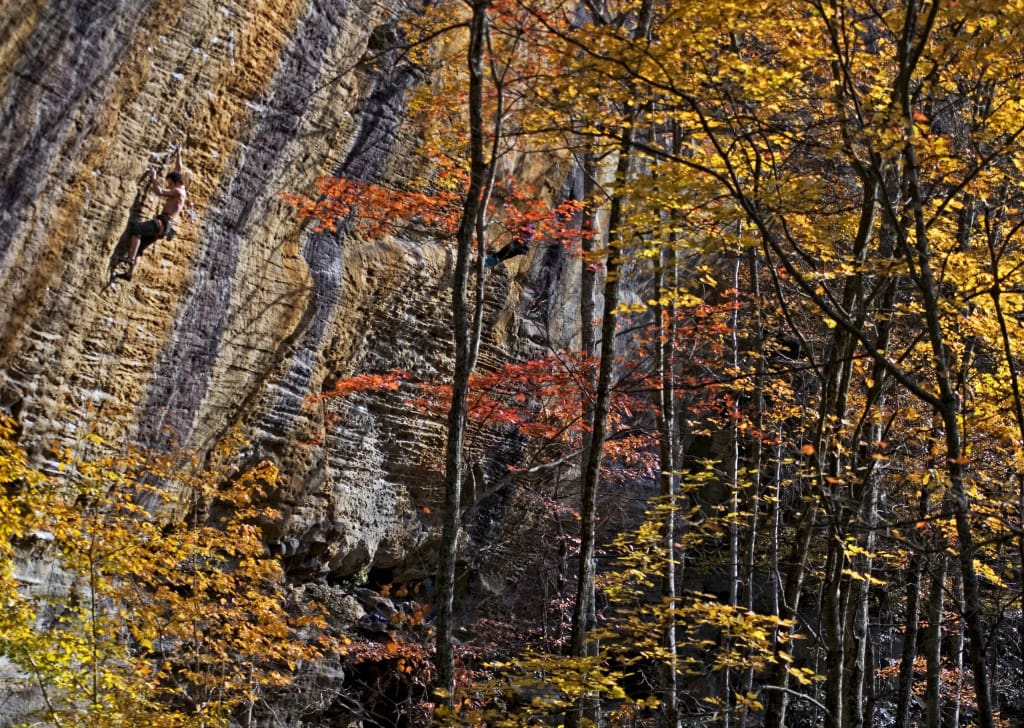Story by Jon Vickers
Brendan Nicholson often takes a scientific approach to his training. With a passion for climbing and a curiosity about the human body, Brendan (Momentum setter ‘Brendan N.’) has researched and implemented a wide variety of training methods and tactics. As a busy designer and first time father, it is important that Brendan gets the most out of any time spent training, and ARCing (along with other training tools) has helped Brendan make the most of his schedule. ARCing, or Aerobic Restoration and Capillarity, has been used to train runners and other endurance athletes for years, but Brendan and other climbers have been benefiting from this method for some time.
Brendan and his friend Brendan Perkins were first introduced to ARCing when they hired the author of “The Self Coached Climber,” Douglas Hunter, for some personal coaching. While the Brendans had already completed 14a and 13d, it turns out the two of them could only continuously ARC around 5.10. Since then, Brendan has continued with ARCing as a staple of his training for not only vascular gains, but as a means to improve technique. The following explanation should help you understand the basic principles of ARCing and the variety of ways it could help your climbing.
What is ARC training? Aerobic Restoration and Capillarity, or ARCing, is a training approach to develop aerobic endurance by encouraging vascular development. In the world of climbing, the goal is to climb for 20 to 40 minutes without surpassing your “anaerobic threshold.” Many articles say this is no more than 30% of your maximum strength.
Brendan explained, “You can change the physiological make-up of your forearms to better increase endurance. ARCing improves the capillary density of your forearms so you can get more oxygen and take away more waste products from your muscles, increasing your ability to stave off the pump.”
The continuous climbing in ARCing keeps blood flowing through the capillaries, forcing them to stay completely open. Over time this steady blood pressure on the capillary walls will stimulate the growth of new capillaries. The result is a greater level of aerobic endurance and the ability to climb more moves before needing to call upon your anaerobic endurance or ‘power endurance’ (often associated with 4×4 training, etc.).
Why ARC? Well, there is that awesome vascularity and endurance thing, but that isn’t all you have to gain according to Brendan Nicholson. ARCing is a great way to improve technique and increase body awareness.
“Because you are doing the lowest intensity, you can do the largest volume of ARCing (as compared to other routines). That includes the largest volume of technique,” explained Brendan. “The more you practice the more you can commit efficient movement to muscle memory. It’s the most bang for your buck when training for technique.”
Who Should ARC? ARCing isn’t only for the elite climber; it is something that can be leveraged for all fitness and experience levels. Not only is it a great low impact way to improve aerobic endurance, it’d also a great way to rack up tons of technical mileage. In fact, the group that may benefit the most from ARCing is beginners.
“When beginners start climbing they have two metaphorical jars. One is empty, and labeled ‘Technique/Experience’ and one is full of marbles which represent future routes or sets of moves,” Brendan explained. “If they follow the standard approach of warming up and then trying their hardest route a few times, they can only move five or six marbles from the full jar to the empty jar during a session. If they complete two dozen routes, or two 20 minute ARCs in a session, they get to move two handfuls of marbles from one jar to the other every time they climb. Sub-maximal climbing is the fastest way for beginners to progress in such a technique-based sport as climbing.”
The fact is, everyone can benefit greatly from ARCing. It is a great way to warm up and/or cool down, it can be incorporated with other routines, or it can act as a light training day. ARCing can provide a large set of technical skills and can even be tailored to intentionally work on your weaknesses or techniques for an upcoming project. And don’t forget the physiological response, which increases your vascular base, in turn increasing your gains from climbing or other types of training.
How to ARC? Arcing is simply climbing in the aerobic zone (30% of your max effort) for a long period of time. Most articles suggest somewhere between 20 and 40 minutes for one ARCing set. An ARCing session can contain one or more sets. Brendan prefers two for the best balance of time and skin. Because 30% of you max is difficult to guesstimate, Brendan suggests using other physiological responses to gauge how close you are to the anaerobic threshold.
“The biggest hurdle to overcome when ARCing is finding the correct intensity. You don’t want to get into the anaerobic pumped zone, but you also don’t want to climb so easily that you don’t see the most benefit from the amount of time you spend ARCing,” explained Brendan.
Since 30% of your max is a relatively abstract number, Brendan suggests you should be sweating and feel very warmed up. If you are not sweating, move faster, increase the angle or decrease the hold size. However, be sure to not ever reach a point where you feel like you might come off in a couple hand moves. Don’t worry if you get slightly pumped, simply move onto an easier angle to recover and continue. If you do fall, immediately jump back onto terrain that you can continue to climb until you recover enough to finish the workout. Beginners may need to shake out regularly to perform this workout at first, but experts should reduce the amount of time they are resting. It isn’t a bad idea to have a set of varied techniques you work on or even create route specific sessions. You can always adjust wall angle and hold type to mimic an upcoming project or goal.
ARCing Courtesy Since ARCing takes up such a large amount of space for such a long time, it is important to be courteous to those you climb with and around. It isn’t appropriate to ARC during busy hours at Momentum or any gym. If you do decide to ARC, make sure to choose reasonable times to do so and to communicate with fellow climbers. Make sure your ARCing isn’t going to hinder their session and make a plan for communicating. While ARCing, try to avoid dominating any one angle or area for too long. If you have access to a home gym, this is often the best place to ARC.
More articles about ARCing and Aerobic Endurance:
Ideas to maximize your technique training while ARCing:
http://lazyhclimbingclub.wordpress.com/2012/09/17/spice-up-your-arc-routine/
A field study showing how to match your training to your climbing goals:
A basic periodized training plan including ARCing:
http://www.rockclimbing.com/Articles/Training_and_Technique/The_Making_of_a_Rockprodigy__258.html
A critique of ARCing showing potential pitfalls:
http://www.powercompanyclimbing.com/2011/03/sinking-arc.html



tsvhjmppvuwewybfdfxodecefekaqmxjztjjnvqqmiluntthtwijtxvyftzf